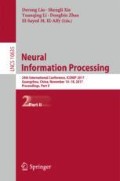Abstract
Various deep convolutional neural networks (CNNs) have been applied in the task of medical image segmentation. A lot of CNNs have been proved to get better performance than the traditional algorithms. Deep residual network (ResNet) has drastically improved the performance by a trainable deep structure. In this paper, we proposed a new end-to-end network based on ResNet and U-Net. Our CNN effectively combine the features from shallow and deep layers through multi-path information confusion. In order to exploit global context features and enlarge receptive field in deep layer without losing resolution, We designed a new structure called pyramid dilated convolution. Different from traditional networks of CNNs, our network replaces the pooling layer with convolutional layer which can reduce information loss to some extent. We also introduce the LeakyReLU instead of ReLU along the downsampling path to increase the expressiveness of our model. Experiment shows that our proposed method can successfully extract features for medical image segmentation.
Access this chapter
Tax calculation will be finalised at checkout
Purchases are for personal use only
References
Brebisson, A.D., Mountana, G.: Deep neural networks for anatomical brain segmentation. In: Proceedings of the IEEE Conference on Computer Vision and Pattern Recognition Workshops (2015)
Zhang, W., Li, R., Deng, H., Wang, L.: Deep convolutional neural networks for multi-modality isointense infant brain image segmentation. NeuroImage 108, 214–224 (2015)
Li, Q., Cai, T., Wang, X., Zhou, Y., Feng, D.: Medical image classification with convolutional neural network. In: the 13th International Conference on Control Automation Robotics & Vision (ICARCV). IEEE (2014)
Ciresan, D.C., Meier, U., Masci, J., Gambardella, L.M., Schmidhuber, J.: Flexible, high performance convolutional neural networks for image classification. In: Twenty-Second International Joint Conference on Artificial Intelligence (2011)
Long, J., Shelhamer, E., Darrell, T.: Fully convolutional networks for semantic segmentation. In: Proceedings of the IEEE Conference on Computer Vision and Pattern Recognition (2015)
Simonyan, K., Zisserman, A.: Very deep convolutional networks for large-scale image recognition. ArXiv preprint arXiv:1409.1556 (2014)
He, K., Zhang, X., Ren, S., Sun, J.: Deep residual learning for image recognition. In: Proceedings of the Institute of Electrical and Electronics Engineers Conference on Computer Vision and Pattern Recognition (2016)
Yu, F., Koltun, V.: Multi-scale context aggregation by dilated convolutions, arXiv preprint arXiv:1511.07122 (2015)
Ronneberger, O., Fischer, P., Brox, T.: U-Net: convolutional networks for biomedical image segmentation. In: Navab, N., Hornegger, J., Wells, W.M., Frangi, A.F. (eds.) MICCAI 2015. LNCS, vol. 9351, pp. 234–241. Springer, Cham (2015). doi:10.1007/978-3-319-24574-4_28
Xu, B., Wang, N., Chen, T., Li, M.: Empirical evaluation of rectified activations in convolutional network. arXiv preprint arXiv:1505.00853 (2015)
Nair, V., Hinton, G.E.: Rectified linear units improve restricted boltzmann machines. In: Proceedings of the 27th International Conference on Machine Learning (ICML 2010) (2010)
He, K., Zhang, X., Ren, S., Sun, J.: Identity mappings in deep residual networks. In: Leibe, B., Matas, J., Sebe, N., Welling, M. (eds.) ECCV 2016. LNCS, vol. 9908, pp. 630–645. Springer, Cham (2016). doi:10.1007/978-3-319-46493-0_38
LeCun, Y., Boser, B.E., Denker, J.S., Henderson, D., Howard, R.E., Hubbard, W.E., Jackel, L.D.: Backpropagation applied to handwritten zip code recognition. Neural Comput. 1(4), 541–551 (1989)
Zhou, B., Khosla, A., Lapedriza, A., Oliva, A., Torralba, A.: Object detectors emerge in deep scene cnns. arXiv preprint arXiv:1412.6856 (2014)
Ioffe, S., Szegedy, C.: Batch normalization: Accelerating deep network training by reducing internal covariate shift. arXiv preprint arXiv:1502.03167 (2015)
Acknowledgments
This research is partly supported by NSFC (No: 61375048).
Author information
Authors and Affiliations
Corresponding author
Editor information
Editors and Affiliations
Rights and permissions
Copyright information
© 2017 Springer International Publishing AG
About this paper
Cite this paper
Zhang, Q., Cui, Z., Niu, X., Geng, S., Qiao, Y. (2017). Image Segmentation with Pyramid Dilated Convolution Based on ResNet and U-Net. In: Liu, D., Xie, S., Li, Y., Zhao, D., El-Alfy, ES. (eds) Neural Information Processing. ICONIP 2017. Lecture Notes in Computer Science(), vol 10635. Springer, Cham. https://doi.org/10.1007/978-3-319-70096-0_38
Download citation
DOI: https://doi.org/10.1007/978-3-319-70096-0_38
Published:
Publisher Name: Springer, Cham
Print ISBN: 978-3-319-70095-3
Online ISBN: 978-3-319-70096-0
eBook Packages: Computer ScienceComputer Science (R0)

